What is The Beachcomber?
The Beachcomber is The Scotch Malt Whisky Society’s 6th blended malt Scotch whisky release. This 7-year-old is a blend of casks of Highland and Campbeltown malt, all matured in American oak first-fill bourbon barrels. It is bottled at 50% ABV and there are 1,999 bottles in the Outturn available worldwide. As with our single malts, it is neither chill-filtered nor coloured.
What is its flavour profile?
The Beachcomber is inspired by the Society’s Oily & Coastal flavour profile. We are unique in our use of this collective term to describe whisky flavour. It captures diverse styles of whisky, from those reminiscent of a baking hot sunny day in the sand dunes surrounded by coastal gorse with the seashore not far away, to those more suggestive of boat harbours, fishing creels and salty sea spray.
What did the Tasting Panel say about it?
A beautiful and evocative nose! Freshness, sunlight, seashore, medical balms, sandalwood, petrichor and wild herb gardens all jostle together for attention. Greenery, waxes, old papers, distant seaweed and complex, fragrant mineral aspects. Dilution offers up bog myrtle, heather flowers, juniper and lemon peel. Superbly fresh! The arrival in the mouth is tart. Raw gooseberry with delicate acidity, cut grass, gorse bush prickle and red apple. Some sea buckthorn, grapefruit pith, Citra hops and buttery cereals. Beguiling stuff! With water there's a kiss of vanilla, some sweet cereals and pink sea salt. Hints of salty liquorice, wild mint leaf, children's medicines, lime zest and brine diluted with extra virgin olive oil. The finish drifts endlessly out to sea. Drink this one with your eyes closed...
How did the Society set about creating The Beachcomber?
SMWS spirits manager Euan Campbell oversaw The Beachcomber’s creation. This is how he describes how he developed its flavour profile:
“With this, I wanted to explore some of the more rugged regions of Scotch malt whisky. Looking to our flavour profiles for inspiration, we decided to experiment with malts that displayed classic coastal characteristics. Exploring our warehouse, we identified a selection of 1st fill bourbon barrels from both Campbeltown and Highland regions as our blending ingredients. After creating and assessing several different recipes and presenting them to the Tasting Panel, we settled on the 12th one, which sits at the lighter end of the flavour profile with just the slightest hint of peat behind a boatload of fruit and coastal evocations. The Panel favoured this for its balance and complexity. A blended malt of great intrigue, displaying remarkable texture and vibrancy.
“For me it’s one to take in the hip flask on a walk, a ready-to-go dram at 50% abv. It’s oily and coastal but herbal, sweet, medicinal, waxy and salty with a mineral tartness.”
What whiskies are in the blend?
As with our single cask, single malts, we do not reveal the provenance of any of our whiskies. The most important factors to emphasize are the Society’s role in creating a blended malt Scotch whisky and the resulting flavour profile, not the whisky’s origin.
Could you tell me where some of the different flavours come from?
It’s flavour that matters at the Society. So rather than declare which distilleries produced the malts we used, here is an explanation of where some of the flavours you’ll find in the Tasting Notes for The Beachcomber come from in the production process.
Spiciness: A reference to ‘liquorice’ by the Panel, not uncommon in whisky from highly active bourbon casks like these. Sometimes aniseed and cloves are evident too. Again, these are cask-derived flavours, with more compounds produced when the wood is heat treated (charred in this case) during cooperage. Organic compounds Guaiacol and Eugenol are the usual suspects here – giving spicy, clove-like, woody, sometimes even smoky aromas to the spirit.
Cereal, Grassy, Herbal: We hear talk of ‘greenery’, ‘wild herbs’, ‘mint leaf’. These are derived from the raw materials and present in the spirit from the still. They are ultimately produced from oily compounds and usually breakdown (oxidize) and reduce in intensity over time during maturation. The ‘sweet cereals’ and herbal references from the panel point towards the relative youthfulness and vibrancy of this spirit, which you wouldn’t otherwise expect based on the amount of lovely sweet, mature wood-derived character in the whisky.
Medicinal and Smoky: ‘Medical Balms’, ‘Sandalwood’, ‘Distant Seaweed’ you say? Descriptors we associate with the peaty whiskies from Islay. Indeed, the peat used at this Cambeltown distillery comes from Port Ellen maltings on Islay, which is renowned for giving medicinal, phenolic, iodine-like notes to the spirit. Chemicals responsible are the phenolic compounds we measure in the infamous ‘ppm’ (parts per million)!
Waxiness: Look carefully and you will see the Panel uses terms which suggest a waxy or oiliness in the whisky. A character which is not well understood chemically or where it originates from in production. But a well-known Highland distillery we encounter here in this blended malt is much revered by blenders for its rare ‘waxy’ character. An important and (almost) irreplaceable component of the world’s biggest selling blended Scotch whisky.
Why has The Scotch Malt Whisky Society decided to create a blended malt whisky?
We have always sought out the best single cask, single malt from distilleries both across Scotland and beyond, but would never shy away from taking an experimental approach in the pursuit of new flavour experiences.
What’s the difference between a blended malt whisky and a blended whisky?
Blended malt whisky refers to a combination of single malts, married together from more than one distillery. Unlike a blended whisky, a blended malt whisky does not contain any grain whisky. Prior to 2009, blended malts were sometimes also referred to as vatted or pure malts, but those terms are no longer permitted by the Scotch Whisky Association.



